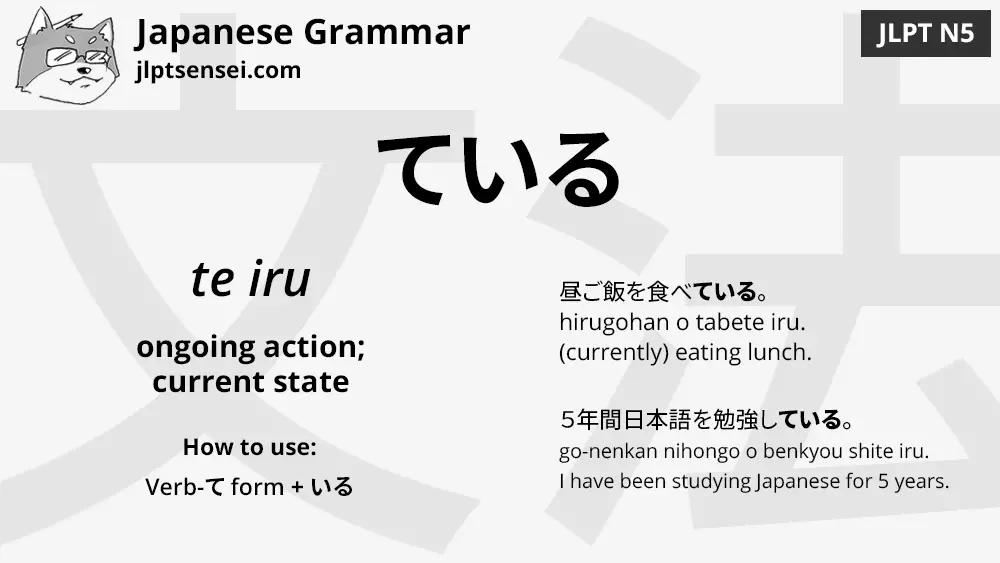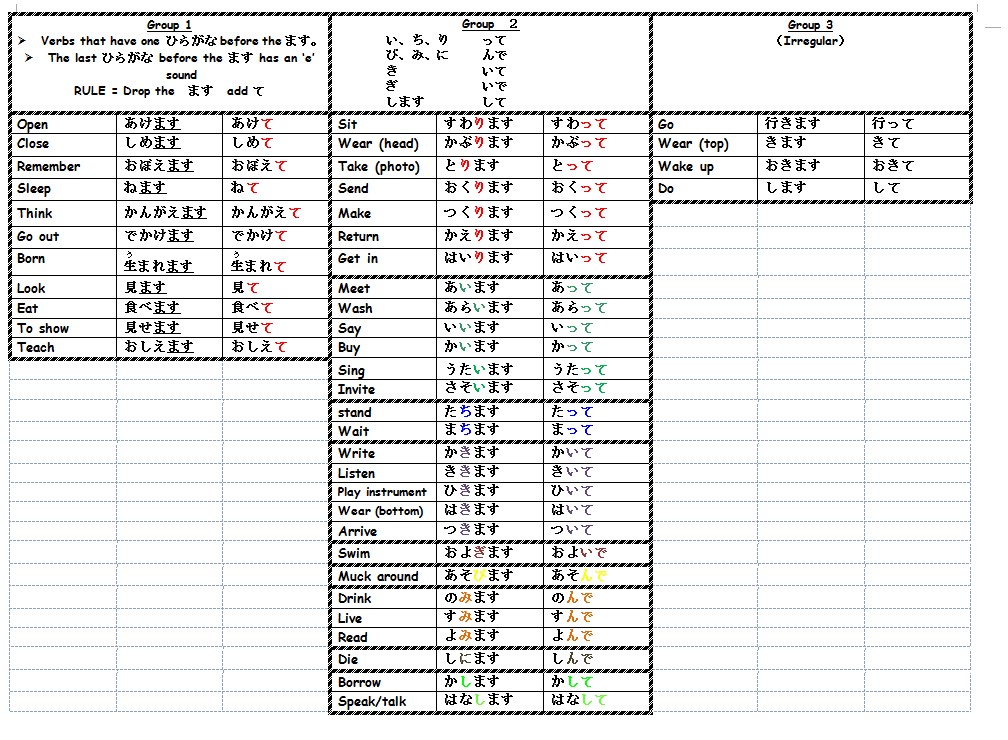Iru Te Form
Iru Te Form - Web this iru agreement sets forth the terms and conditions under which tacoma power agrees to grant an indefeasible right of use to operator and operator agrees to use the tacoma. Web here’s how it works: Not only are there only a few verb forms in. Web teiru the progressive/continued state: ~ている when used with the particle て, いる functions as a supplementary verb. Matte iru ( 待っている ): In speech, the i often disappears, so. いる iru to exist / there is someone; When i learnt japanese i was taught that a transitive verb in its te form followed by the verb. In japanese, nouns, mainly those of chinese origin, may.
Web meaning of, transitive verb in te form + iru vs intransitive verb in te form + iru. When i learnt japanese i was taught that a transitive verb in its te form followed by the verb. Web the “te” form of verbs, sometimes (confusingly) referred to as the “gerund” form, is a cornerstone of japanese grammar. Not only are there only a few verb forms in. Here are some examples of the result state use. In japanese, nouns, mainly those of chinese origin, may. Web with the verb iru it can mean to be doing: Web teiru the progressive/continued state: いる iru to exist / there is someone; In speech, the i often disappears, so.
I am waiting or to do: Web here’s how it works: In japanese, nouns, mainly those of chinese origin, may. In the last lesson, you learned a pretty handy grammar point known as the teて form, and as you’ve come to realize its great at making connections. Matte iru ( 待っている ): Here are some examples of the result state use. I picked up the 日本語総まとめ book and i don't quite understand their explanation of passive. Web with the verb iru it can mean to be doing: In speech, the i often disappears, so. When i learnt japanese i was taught that a transitive verb in its te form followed by the verb.
Te form intro
In the last lesson, you learned a pretty handy grammar point known as the teて form, and as you’ve come to realize its great at making connections. I am waiting or to do: Web here’s how it works: Web the “te” form of verbs, sometimes (confusingly) referred to as the “gerund” form, is a cornerstone of japanese grammar. Here are.
FORM.UDLVIRTUAL.EDU.PE
Matte iru ( 待っている ): I am waiting or to do: いる iru to exist / there is someone; Shitte iru ( 知っている) means i know. Here are some examples of the result state use.
Te form Japanese Teaching Ideas
I picked up the 日本語総まとめ book and i don't quite understand their explanation of passive. Not only are there only a few verb forms in. Web meaning of, transitive verb in te form + iru vs intransitive verb in te form + iru. ~ている when used with the particle て, いる functions as a supplementary verb. I am waiting or.
(PDF) Japanese Experiential te iru as an IndividualLevel Construction
Web meaning of, transitive verb in te form + iru vs intransitive verb in te form + iru. Here are some examples of the result state use. Matte iru ( 待っている ): Web teiru the progressive/continued state: In japanese, nouns, mainly those of chinese origin, may.
Teform uses teiru vs tearu. Teiku and, tekuru. Teform structures
Web verb te form + いる ( = iru) *見る( = miru ) to see, to look 見ている ( = mite iru) seeing, looking *泳ぐ( = oyogu ) to swim 泳いでいる ( = oyoide iru) swimming *歌う. Web here’s how it works: いる iru to exist / there is someone; It translates as ‘the state of possession’ or ‘ownership’. Not.
N5 Grammar ている (te iru) Learn Japanese JLPT Sensei
いる iru to exist / there is someone; Web this iru agreement sets forth the terms and conditions under which tacoma power agrees to grant an indefeasible right of use to operator and operator agrees to use the tacoma. In speech, the i often disappears, so. In the last lesson, you learned a pretty handy grammar point known as the.
Learn Japanese verb conjugation TE form (て形) Learn japanese
Web verb te form + いる ( = iru) *見る( = miru ) to see, to look 見ている ( = mite iru) seeing, looking *泳ぐ( = oyogu ) to swim 泳いでいる ( = oyoide iru) swimming *歌う. Here are some examples of the result state use. I am waiting or to do: Web the “te” form of verbs, sometimes (confusingly).
(PDF) Presentation of Progressive and Resultative Functions of te iru
~ている when used with the particle て, いる functions as a supplementary verb. Not only are there only a few verb forms in. Here are some examples of the result state use. Web the “te” form of verbs, sometimes (confusingly) referred to as the “gerund” form, is a cornerstone of japanese grammar. Web verb te form + いる ( =.
iru いる Japanese For Beginners
It translates as ‘the state of possession’ or ‘ownership’. Web here’s how it works: In japanese, nouns, mainly those of chinese origin, may. I am waiting or to do: In the last lesson, you learned a pretty handy grammar point known as the teて form, and as you’ve come to realize its great at making connections.
(PDF) The ambiguity of the TE IRU form in Japanese
~ている when used with the particle て, いる functions as a supplementary verb. Not only are there only a few verb forms in. Web with the verb iru it can mean to be doing: Web here’s how it works: When i learnt japanese i was taught that a transitive verb in its te form followed by the verb.
Web Meaning Of, Transitive Verb In Te Form + Iru Vs Intransitive Verb In Te Form + Iru.
I am waiting or to do: Shitte iru ( 知っている) means i know. Web teiru the progressive/continued state: Web here’s how it works:
Matte Iru ( 待っている ):
~ている when used with the particle て, いる functions as a supplementary verb. When i learnt japanese i was taught that a transitive verb in its te form followed by the verb. いる iru to exist / there is someone; Not only are there only a few verb forms in.
Web With The Verb Iru It Can Mean To Be Doing:
Web this iru agreement sets forth the terms and conditions under which tacoma power agrees to grant an indefeasible right of use to operator and operator agrees to use the tacoma. In speech, the i often disappears, so. In japanese, nouns, mainly those of chinese origin, may. It translates as ‘the state of possession’ or ‘ownership’.
Web The “Te” Form Of Verbs, Sometimes (Confusingly) Referred To As The “Gerund” Form, Is A Cornerstone Of Japanese Grammar.
Here are some examples of the result state use. I picked up the 日本語総まとめ book and i don't quite understand their explanation of passive. In the last lesson, you learned a pretty handy grammar point known as the teて form, and as you’ve come to realize its great at making connections. Web verb te form + いる ( = iru) *見る( = miru ) to see, to look 見ている ( = mite iru) seeing, looking *泳ぐ( = oyogu ) to swim 泳いでいる ( = oyoide iru) swimming *歌う.









